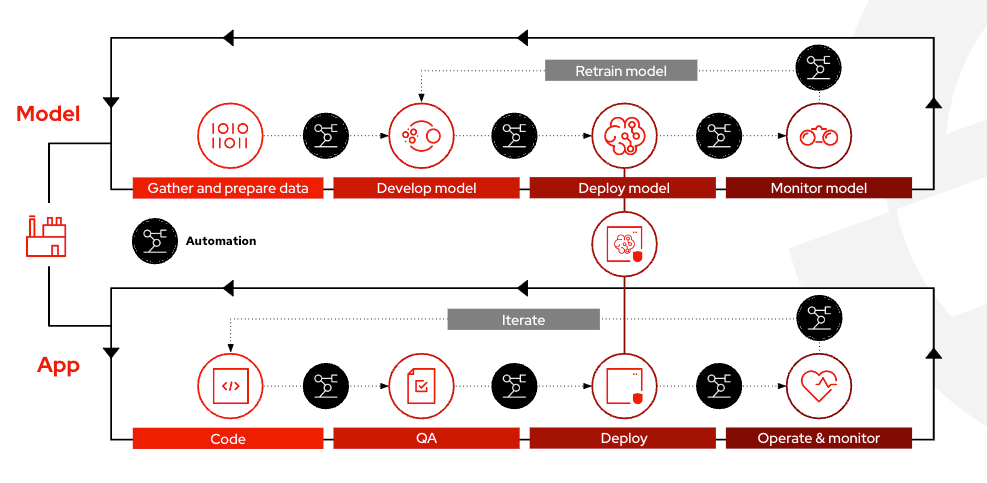If you joined me at Red Hat Summit 2023, you heard Matt Hicks beat the drum of one of the most prominent and compelling technologies of the current moment–artificial intelligence (AI). AI is the very definition of a “hot topic” right now, both inside and outside of the IT community, and it’s here to stay. At every turn, the media, analysts, business leaders, government officials and seemingly everyone you follow online, have something to say about AI, regardless of their industry.
The multifaceted nature of AI and the complexities of its proven and potential use cases are some of the reasons why it makes for a meaningful and timely point of discussion–and why enterprises can no longer ignore it if they want to drive their organizations forward, even if they aren’t sure when, how or where to begin.
AI now, AI everywhere
We know that the next iteration of countless technologies will be based on AI, whether it’s in the form of chat bots, software-defined vehicles, financial fraud detection or accelerated patient diagnostics. In order to survive and advance in today’s economic and technological climate, it’s imperative that business leaders prioritize implementing AI in a strategic, holistic and timely manner so that data scientists, developers and IT operations teams can together effectively operationalize AI across the business.
Per Gartner, “AI has the potential to bring significant value to organizations by enhancing productivity, improving decision making, and creating new opportunities for growth and innovation.”1, though some enterprises still choose to limit AI’s scope and have yet to adopt AI in more than one business function2.
Enterprises have to consider how AI can help increase productivity or help drive revenue and differentiation. By not taking full advantage of what AI has to offer, these enterprises are passing up reduced operational costs and complexities and the opportunity to gain deeper engagements and insights that help deliver better customer experiences.
If organizations want to equip themselves to use AI effectively, they need to be able to:
- Operationalize their AI use cases from idea to production by bringing different teams, such as data scientists, developers and IT ops and technologies together
- Use existing tools and processes that enable their teams to quickly drive agility and efficiency that accelerates deploying AI-enabled applications into production
- Meet security, regulatory, compliance and governance standards, just as they do with other business applications
Simply put, without a proactive, comprehensive action plan on how to adopt AI across their business, enterprises will likely struggle to adapt to their customers’ changing needs.
AI with Red Hat
Combining the collaborative nature of open source with the power of AI enables Red Hat to help enterprises solve the world’s problems more effectively and quickly than many would have thought possible before the emergence of AI. Without it, who knows if HCA Healthcare could have created a real-time predictive analytics product system to more accurately and rapidly detect sepsis, or how NTT East would have developed a video AI service that delivers intelligent business insights and reduced their service operating costs by 50-60% with improved management and version control. Thankfully, Red Hat not only sees the power AI can bring to enterprises today, but also the possibilities of what it could bring tomorrow.
When it comes to AI, Red Hat focuses on:
- Integrating open source technologies to bring use cases to life
- At Red Hat, we believe open source communities are where innovation begins, and this is especially true when it comes to AI. Our deep-rooted relationships with open source communities such as Kubeflow, KServe, CodeFlare and Ray, open source models from companies like Hugging Face and our upstream first approach allows us to foster open, transparent contributions, leading to downstream innovation with our partners. Red Hat’s collaborative relationships with hardware and software partners allows for flexible deployment of AI models–helping customers build a more complete AI solution–from data acquisition and preparation, to monitoring and maintenance, to hardware acceleration–based on their unique use case.
- Accelerating time to value
- Red Hat brings together data scientists and developers to deliver AI-enabled applications faster and be more reactive to changes–helping go from hypothesis to model development to deployment and measurement while driving efficiencies and collaboration across teams.
- There are many parallels between the pipelines used for traditional apps and those used for model development. As models and applications change, Red Hat OpenShift AI and Red Hat OpenShift help both MLOps and DevSecOps practitioners to iterate quickly through tools that help build the appropriate guardrails. Automating and streamlining these processes can help lead your organizations to greater efficiency and efficacy.

- Deploying AI-enabled applications anywhere
- Red Hat helps organizations build, deploy, manage and operate AI-enabled applications across any cloud–public or private, on-premise or at the edge–at scale and with greater security capabilities, providing customers with the ability to deploy a more flexible and consistent computing platform. This flexibility allows Red Hat to support organizations that are concerned with data privacy, gravity or sovereignty by moving AI models closer to data sources, helping them build and use AI models in alignment with regulatory requirements that restrict the movement of data.
- Sometimes you need to embrace data gravity instead of fighting it, and Red Hat OpenShift allows you to do just that. With Red Hat OpenShift and Red Hat OpenShift AI, you can train in the cloud and bring the model back to your private data center if you need a high number of GPUs for a shorter training time–you can even rent them in the cloud.
- Increasing efficiency and productivity
- Red Hat provides the platforms needed to rapidly develop and deploy AI at scale and integrates AI into our existing platforms to improve the productivity and efficiency of both operations and developer teams, making them easier to use. This is crucial for organizations that need to innovate quickly while facing challenges such as talent shortages. For example, Red Hat Ansible Lightspeed with IBM watsonx Code Assistant utilizes generative AI to produce Ansible code that is compliant with Red Hat best practices, reliable and helps bridge the IT automation skills gap.
- The ability to properly scale after integrating AI into your products is also an important consideration for enterprises. Red Hat Openshift AI accounts for this by allowing you to increase the number of replicas, or even deploying multiple replicas, of a model to multiple clusters on multiple clouds.
Built on transparency and choice, Red Hat’s enterprise-ready AI solutions make it possible for you to apply AI to every day business. The power of AI is here, it’s open, it's real–and with Red Hat, it can be yours.
Red Hat is eager to hear about your experience with AI. Please consider taking our Strategy, AI and Culture Report Survey.
About the author
Ashesh Badani is Senior Vice President and Chief Product Officer at Red Hat. In this role, he is responsible for the company’s overall product portfolio and business unit groups, including product strategy, business planning, product management, marketing, and operations across on-premise, public cloud, and edge. His product responsibilities include Red Hat® Enterprise Linux®, Red Hat OpenShift®, Red Hat Ansible Automation, developer tools, and middleware, as well as emerging cloud services and experiences.
Previously, Badani was Senior Vice President of Cloud Platforms, where he helped solidify the company as a hybrid cloud and enterprise Kubernetes leader. Under his leadership, Red Hat has also expanded OpenShift from an award-winning Platform-as-a-Service solution to the industry’s leading enterprise Kubernetes platform, with 1,000+ customers spanning all regions and industries. Badani started at Red Hat overseeing product line management and marketing for the Red Hat JBoss® Enterprise Application Platform middleware portfolio.
Badani has played a significant role around strategy, analysis, and integration for key Red Hat acquisitions—including StackRox in 2021, CoreOS in 2018, and FuseSource in 2012—to bolster the company’s integration portfolio.
Prior to joining Red Hat, Badani served as Director of Product Management and Product Marketing of Integration and Application Platform Products at Sun Microsystems. He has more than 20 years of experience in the technology and finance industries at both established and emerging companies.
More like this
Browse by channel
Automation
The latest on IT automation for tech, teams, and environments
Artificial intelligence
Updates on the platforms that free customers to run AI workloads anywhere
Open hybrid cloud
Explore how we build a more flexible future with hybrid cloud
Security
The latest on how we reduce risks across environments and technologies
Edge computing
Updates on the platforms that simplify operations at the edge
Infrastructure
The latest on the world’s leading enterprise Linux platform
Applications
Inside our solutions to the toughest application challenges
Original shows
Entertaining stories from the makers and leaders in enterprise tech
Products
- Red Hat Enterprise Linux
- Red Hat OpenShift
- Red Hat Ansible Automation Platform
- Cloud services
- See all products
Tools
- Training and certification
- My account
- Customer support
- Developer resources
- Find a partner
- Red Hat Ecosystem Catalog
- Red Hat value calculator
- Documentation
Try, buy, & sell
Communicate
About Red Hat
We’re the world’s leading provider of enterprise open source solutions—including Linux, cloud, container, and Kubernetes. We deliver hardened solutions that make it easier for enterprises to work across platforms and environments, from the core datacenter to the network edge.
Select a language
Red Hat legal and privacy links
- About Red Hat
- Jobs
- Events
- Locations
- Contact Red Hat
- Red Hat Blog
- Diversity, equity, and inclusion
- Cool Stuff Store
- Red Hat Summit

